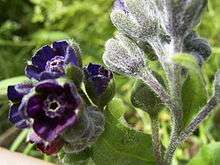Cynoglossum
There are many species in the plant genus Cynoglossum (/ˌsɪnoʊˈɡlɒsəm, ˌsaɪ-, -nə-/[1][2]). They are coarse-appearing, small-flowered plants of the family Boraginaceae. Cynoglossum officinale, the common hound's-tongue, is a native of Asia, Africa, and Europe. It has been introduced into North America, and it is considered to be a troublesome weed because its burs stick to the wool of sheep and to other animals. Ingestion of this plant can also lead to photosensitivity in grazing animals.
| Cynoglossum | |
|---|---|
 | |
| Cynoglossum officinale | |
| Scientific classification | |
| Kingdom: | Plantae |
| Clade: | Tracheophytes |
| Clade: | Angiosperms |
| Clade: | Eudicots |
| Clade: | Asterids |
| Order: | Boraginales |
| Family: | Boraginaceae |
| Subfamily: | Boraginoideae |
| Genus: | Cynoglossum L. |
| Type species | |
| Cynoglossum officinale L. | |
| Species | |
|
See text. | |
Cynoglossum virginianum, known as wild comfrey, is a common plant from New York to Florida. Cynoglossum boreale occurs in the northern United States as far west as Minnesota and in Canada.
Cynoglossum amabile, known as Chinese Forget-me-not and Chinese hound's tongue, originally a wildflower from Southwest China, is now found in Europe and North America.
Cynoglossom grande is native to California.
In Iran there are 3 species of this plant from which Cynoglossum tehranicum is only found in Iran.[3]
Selected species
- Cynoglossum amabile - Chinese hound's tongue, Chinese forget-me-not
- Cynoglossum apenninum
- Cynoglossum australe - Australian hound's tongue
- Cynoglossum baeticum
- Cynoglossum boreale - northern wild comfrey
- Cynoglossum castellanum
- Cynoglossum cheirifolium
- Cynoglossum clandestinum
- Cynoglossum columnae
- Cynoglossum creticum - blue hound's tongue
- Cynoglossum dioscoridis
- Cynoglossum furcatum - Indian hound's tongue
- Cynoglossum germanicum - green hound's tongue
- Cynoglossum glochidiatum - prickly hound's tongue
- Cynoglossum grande - Pacific hound's tongue
- Cynoglossum hungaricum
- Cynoglossum magellense
- Cynoglossum microglochin - smallbristle hound's tongue
- Cynoglossum nervosum - hairy hound's tongue
- Cynoglossum occidentale - western hound's tongue
- Cynoglossum officinale - common hound's tongue, gypsyflower
- Cynoglossum reverchonii
- Cynoglossum rotatum
- Cynoglossum sphacioticum h. riedl.
- Cynoglossum suaveolens - sweet hound's-tongue[4]
- Cynoglossum tehranicum = Cynoglossum montanum = Cynoglossum nebrodense - mountain hound's tongue.[3]
- Cynoglossum troodi - Troodos hound's tongue
- Cynoglossum virginianum - wild comfrey
- Cynoglossum zeylanicum - Ceylon hound's tongue
References
- Sunset Western Garden Book, 1995:606–607
- "Pronunciation Guide for Plants". Retrieved 2016-01-23.
- Mozaffarian, V. 1996. A dictionary of Iranian plant names: Latin, English, Persian. Tehran: Farhang-e Moʻaser.
- "Cynoglossum". Australian Plant Name Index (APNI), IBIS database. Centre for Plant Biodiversity Research, Australian Government, Canberra. Retrieved 2008-11-26.